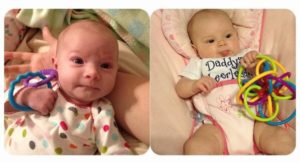
How babies find and use their hands
A baby’s grasp is reflexive, and most young babies keep their hands tightly fisted, or curled closed, when they are awake and alert. You’ll notice your baby’s fists soften and open slightly when they are relaxed, such as halfway into a feeding or asleep.
Even though their fists are closed, the grasp reflex is present. When a baby feels something on their palm, he’ll usually respond by curling his fingers and holding on. By offering appropriate objects in an intentional way, you can help your baby become more aware of their hands and arms, and explore the movements and coordination leading to hand and arm control. The increasing voluntary control of the hands and fingers is called “Fine Motor Development”. (“Gross Motor Development” are bigger body movements like sitting and pulling to a stand – Learn more about How Babies Develop)
You can help your young baby build increasing awareness of their hands and work on developing more voluntary control over the movements of arms and hands by taking advantage of the grasp reflex.
Baby’s first “toy” – Just a pair of links.
Take two simple baby toy “links”, clicked together, and place them in your baby’s palm. If his fist is closed tightly, try tapping on the small part of your baby’s exposed palm below the curled fingers. The fingers will quickly relax then tighten again. Take that moment to gently unfold his fingers to place the link in his palm, then loop it over his fingers. This way, his thumb will serve as a hook to help keep the links in his hand even if his hand opens and closes several times over the playtime.
Once your baby is holding the pair of links, he’ll randomly move arms and hands, and when doing so, the links will gently click and clack. Over time, your baby will begin to move his arms and hands more, and will also bring his hand up to the mouth. As soon as a baby can deliberately bring hands toward the mouth, he will: this isn’t necessarily a sign of hunger or an emerging tooth. It’s a very normal developmental behavior that means “Awesome! I can get my hands in my mouth now! Nom Nom!” Your baby will mouth his hands and fingers, and any portion of the links that he can bring to his mouth.
Try “playing” with the links each day. You’ll probably notice that your baby begins to seem more aware of his hands when he’s holding the links and begins to move them with more intention.
ALSO: Add additional links to the toys that dangle down from your baby’s playmat arches so that his still-very-random arm and leg movements can connect with the toy. Bring the toys down to where your baby’s natural movements happen to be. Your baby may not be able to reach out and grab at the toys dangling over him for a while yet, but if the toys are dangling close to their hands, they will become much more interested and engaged.
Often babies will flail out with an arm or hand and hit a toy over and over, making it rattle and move, while looking off in a completely different direction. Just because he’s not looking, doesn’t mean he’s not working hard to figure out how to move his body to connect with the toy. ALSO moving his head, and the cognitive steps of his understanding what he’s seeing (wow, that’s my arm, with my hand, hitting that toy, which is making that noise) is still a whole lot of information to process. If he’s swiping out with his arm to connect with a toy over and over, he’s showing you a new purposeful skill even if he’s not looking.
Texture Exploration: let your baby feel different types of textures by helping him stroke his hand or fingers over things. Touch soft, hard, shiny, fluffy, warm, cool, crunchy, velvety, scratchy textures, and verbally describe for her what it feels like (called “narrating your activities”).
– Good early/first “toys” (you’re doing most of the work) – the simple pair of links. Other perfect early toys include soft fabric books, crunchy and crinkly toys and fabrics, and easy grasp rattles that are lightweight, easy to hold and easy to clean.
What comes next? You’ll begin to see one hand to the mouth more and more often by three months. Watch to see if your baby brings hands together to midline (the center of the body) when in the carseat or sitting upright. Usually by three months, your baby will be interested in grasping and clutching his own hands together, and by four months, will be working very hard at getting both hands in the mouth at the same time. He’s got to make room in there, because around five or six months, he’ll be trying to bring his foot into his mouth. Really! Fun times ahead.
A portion of this article appeared on the Baby+Co blog